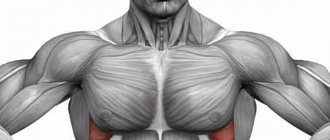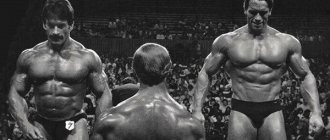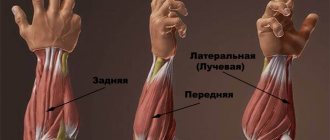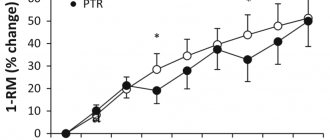What is a training plateau?
A training plateau is a state of the body in which the growth of basic physical indicators (strength, mass, endurance, speed, etc.) stops due to the adaptation of muscles to the same type of physical activity.
It has been scientifically proven that muscle growth occurs when physical activity is unusual for the muscles and is perceived as stress. To ensure such a load in bodybuilding, a stepwise increase in working weights is most often used in each workout. Thus, the muscles do not have time to adapt to the new load and begin to grow under its influence.
Another way to provide a new load is to periodically change both the order of the exercises performed and the exercises themselves as a whole.
Based on the characteristics of muscle growth and increasing their strength capabilities, training complexes in bodybuilding and powerlifting are constantly changing. There is a scientific opinion that no training program, no matter how successful, lasts longer than 2 months. It is for this reason that the theory of training periodization was developed, which allows you to constantly increase both working weights and muscle mass without driving the body into a training plateau.
Many beginners, due to lack of experience and knowledge, often train according to the same program for a whole year. Such training does not bring the desired result and forces the athlete to give up the sport without seeing further progress.
Signs of a training plateau
- In bodybuilding – growth stagnation or reduction in muscle mass.
- In powerlifting - stopping or reducing working weights.
It must be said that such changes can occur even against the background of a normal diet and rest, as well as against the background of the athlete’s complete health.
Very often, a training plateau is a sign of the onset of overtraining.
Methods for overcoming a training plateau
- Increasing calorie intake;
- Periodic use of shock training;
- Providing sufficient rest for the muscles;
- Changing the training complex;
- Transition to high-intensity training.
How to overcome a training plateau?
Rest
The first thing to do is reduce your training volume by 20-30%. Give your muscles a chance to recover, but don't give up on training. Change the type of physical activity.
Training process
The next thing to do after reducing your running volume is to introduce variability into your training. Perhaps you are simply mentally tired of the routine. Figure out how to add variety to your schedule. Add fartlek to your long runs or change your route. Temporarily replace road running with training in a forest or park area with changing terrain. When working out in the gym, change your training program, replace the exercises performed with their analogues for the same muscle groups.
Nutrition
If you are going to progress, then nutrition is an extremely important element of the training process. Increase your calorie intake by eating more frequently. Monitor the nutritional value of the foods you consume.
Dream
Sleep is a critical component to improving performance. Recovery is essential during strenuous workouts, so give it plenty of time. Try to sleep as much as your body requires. If possible, do not neglect sleep during the day.
Running and strength training
The question of how to combine running and strength training is an extremely frequently asked and relevant one. It is very important to understand which of these areas is a priority for you and which is auxiliary. Long-distance running is extremely energy-intensive; it leaves virtually no energy for building muscles and lifting heavy weights. At the same time, excess weight, even if working, does not contribute to overcoming the marathon distance. Therefore, achieving growth in performance in both sports becomes an almost impossible task. Spend no more than 20-30 minutes of cardio 2-3 times a week if you prefer bodybuilding, and do work in the gym aimed exclusively at developing the muscles involved in running if you are a stayer/runner.
We should not write off those processes that occur in our lives besides training: stress at work, insufficient sleep, fatigue from business trips, poor nutrition. It is important to remember that our overall well-being also affects the quality of our training. Try to maintain balance in all areas of your life.
Based on materials from: running.competitor.com, ferrum-body.ru
What is a “training plateau”?
There are several main reasons for stagnation in training. This is often an indication that you have reached your intermediate peak fitness. This usually happens when there is too sudden a jump to a new level, and the body is not physically ready to move to the next one. The right decision in this case would be to shift the emphasis from running training to cross training and, having strengthened the muscles, make the next “throw”.
The second reason, which is less pleasant, is overtraining. The growth in indicators is due to a regular increase in load. If you do not constantly stress your muscles, they quickly adapt to the working weights or running volumes, and, as a result, a training plateau occurs. On the other hand, if the loads increase, then sooner or later a moment comes when the body simply ceases to cope with the increasing intensity, volumes and weights or speeds.
The onset of a training plateau can be determined by the following signs:
- bodybuilding – lack of muscle mass gain;
- powerlifting – stopping the growth of strength indicators;
- running and other cyclic sports - decreased speed, fatigue;
- decreased level of motivation;
- increased heart rate;
- -decreased appetite and general fatigue.
Other Causes of a Training Plateau
These are the so-called “optional” reasons. In most cases, the reason for the “PLATEAU” is the lack of LOAD PROGRESSION or the lack of the required TIME FOR GROWTH! But there are also smaller reasons that arise from the most important ones.
Genetic ceiling
Sooner or later, reaching a “plateau” is inevitable due to natural limitations. We know that 200 kg of pitching does not occur in nature. Obviously there are some genetic limits. And the closer you get to this “limit”, the more your muscle growth slows down. The greater the chance of ending up in a state of stagnation. There are a number of purely physical explanations for this. For example, the larger your muscles, the more difficult it is to provide them with nutrients (more powerful pressure must be created for transportation), the greater the load on all other systems of the body (energy, musculoskeletal, etc.). Ceiling!
People often talk about reaching their “ceiling” in situations where they still have room to grow. This explanation is simply very convenient because it shifts the responsibility from your shoulders to some kind of “genetics”.
However, the basic rules of the game remain the same : achieve progression of load and growth will continue! However, there are difficulties in the advanced stages. But they are most often associated with the lag of all other SYSTEMS OF THE ORGANISM! A person develops only the contractile apparatus of muscles (this is not the most difficult task, by the way), and all his other systems lag further and further behind. As a result, energy, ligaments, bones and even the central nervous system are not able to ensure the functioning of such a large “building”. I often use the analogy of a toilet and a multi-story building. If you decide to build a tall building on the site of a one-story toilet, then you will not succeed without rebuilding all other communications and the foundation. And the higher your building, the more you need to rebuild all other systems so that they COMPLY!
TREATMENT: MICRO-PERIODIZATION
You alternate training to develop different body systems in order to strengthen the “foundation”. During heavy lifts you stand the building itself (muscles), and during light lifts you expand the foundation (energy).
Micro-periodization always works! It’s just that few people understand its benefits. And if for beginners this is not a mandatory component (their building is still too small and more like a “one-story toilet”), then FOR BIG GUYS MICRO-PERIODIZATION IS MANDATORY!!! Otherwise, a “plateau” will occur due to a weak foundation.
Violation of the regime
Violation of the regime is a very common cause of stagnation. But I called it "optional" because it has an indirect effect. Violation of the regime worsens rest, and therefore affects its duration. The worse your regimen, the more time you need for your muscles to recover and grow. In other words, this all affects the main reason - REST TIME!
Violation of the regime is all that will affect this time. In particular, this is NUTRITION, PHYSICAL REST and even MENTAL REST!
If you lived with your parents and ate meat every day, and then suddenly moved to a student dorm and started eating potatoes and water, then it is obvious that your recovery capabilities have decreased and you need to increase the rest time between workouts. And if you have a session during which you cannot sleep normally because you watched +100500 and House 2 all semester instead of studying gradually. And before each exam, in addition to a sleepless night, you have a nervous state, THEN your recovery time lengthens even more and this needs to be corrected. Otherwise there will be stagnation.
Recommended 183. Gods of Aesthetics: Frank Zane. How the men's physicist staggered the jocks!
Almost all environmental factors influence your recovery time in one way or another. Something shortens it (calmness, sleep during the day, plenty of quality food, self-confidence, etc.), and something greatly lengthens it (nerves, bad food, short sleep, etc.). Take this into account!
Wrong workouts
Incorrect training is also an indirect factor. But which directly affects the main thing - PROGRESSION OF LOAD! You remember that the load on the muscles should increase from workout to workout. If this is present, then there will be growth (supercompensation). If this is not the case, then there will be a “donut with a hole.”
Check the database
Any sports goal can only be achieved if the basic rules are followed. Before you start looking for complex solutions, answer these simple questions honestly:
- Do I have a clearly defined goal?
- Is my training leading to this goal or am I distracted by interesting but unhelpful exercises and methods?
- Are my expectations too high? (Am I really planning on gaining 20kg of muscle in a month?)
- Am I doing the hard, “big” exercises that get results?
- Am I progressing with these exercises by increasing the weight I use?
- Do I keep a training diary?
- Am I missing workouts?
- Am I following through with the program or am I changing them too often?
- Do I regularly evaluate my progress in an objective manner (in the case of hypertrophy, by measurements)?
Also be sure to check everything you do outside the gym:
- Is my diet helping me achieve my goal? Do I keep a food diary?
- Do the sports supplements I take help me?
- Am I getting enough sleep?
- Am I giving my muscles enough rest? (Does two hours of basketball after strength training affect them?)
- Am I managing stress and doing everything I can to eliminate unnecessary worries from my life?
Yes, you've heard it all a hundred times. The only question is, do you do this all the time? Go through the list and then tackle all the “no” answers. Most people embark on exotic experiments, forgetting about the basics: targeted training, proper nutrition, high-quality recovery.
Assess mobility, stability and symmetry
Sometimes progress stops because the body simply doesn't want to get injured. For example, it will not allow you to go further in presses if your shoulder joint is not feeling well, or in squats if you have problems with your hips or lower back. Here's what you can do:
- Take a test to assess your condition (Functional Movement Screen or other) from a qualified trainer. The fastest way to diagnose and fix problems is by calling a professional. However, if one is not available, the following points will help you.
- Take photos of yourself from all angles, standing up straight. Perfect posture? Are there any visible distortions, both in the skeleton and in muscle development?
- Compare the working weights in the exercises. For example, if you do incline dumbbell presses, can you flip onto your stomach and do rows with the same weights? You should be able to - unless, of course, you are a powerlifting champion. Ronnie Coleman and Dorian Yates benched as much as they bench pressed, and they had the best backs in the history of bodybuilding.
- Move different joints on the left and right sides of your body, comparing sensations and noting differences.
- Try different stretches, also comparing the elasticity of the muscles on both sides of your body.
- Roll on a foam roller or soft ball with all major muscle groups. Note where there is pain and massage these places at least once a day.
- Do some unilateral exercises: one-leg deadlift, one-arm bench press, one-leg squat, etc. Compare the results not only in strength, but also in joint mobility, stabilization and coordination.
- Take a video of your usual exercises, such as squats. Then carefully look at how the pelvis lowers, to see if there are any distortions or turns.
Training plateau in bodybuilding: methods of struggle
Training plateau in bodybuilding
Poor appetite, lack of results in training and muscle mass gain, increased nervousness, lack of motivation, changes in heart rate - all this may indicate overtraining in bodybuilding or the emergence of such a common problem as a training plateau . But this can and must be fought. How? In this article we will discuss seven of the most effective ways.
Take a week's rest once every 6-8 weeks
For some reason, many athletes are sure that muscles grow only during training. This is wrong. Muscle fibers increase in volume primarily during rest. During exercise, muscles are destroyed, and during breaks they are restored. Therefore, during the training process it is worth giving the cells complete rest. Otherwise, there will be no result even from the most ideal training program.
Pay special attention to sleep - it should be at least eight hours. In less time, the body and muscle fibers will not have time to recover. In addition, avoid stressful situations. It’s difficult to do this, but at least it’s worth minimizing your worries.
{AF}Once every two months, give your muscles a week's break so that they can fully rest and recover. Even cardio training is contraindicated during this period.{/AF}
The body must have 7 days of complete rest. Why is this necessary? There are several reasons:
- Firstly, ligaments and joints are completely strengthened;
- Secondly, the muscles have enough time to fully recover;
- Thirdly, upon returning to the gym, the athlete is charged with energy and ready for new achievements;
- Fourthly, knowing that rest is ahead allows you to better concentrate on doing the exercises;
- Fifthly, in a week the central nervous system, whose resources have been significantly depleted, has time to rest.
A week of rest should really become like that. If loads outside the gym are planned at any time, then the break must be rescheduled so that the muscles do not experience any stress for at least 5-7 days.
Use the drop set technique
In recent years, the drop set technique has become very popular in bodybuilding. What is its essence? Here we are talking about increasing the intensity of the workout after muscle failure.
The drop set system is simple. For example, you do the first repetition with a weight of 30 kilograms for 8 repetitions, the next drop set is already 25 kg and six repetitions. Next - 20 kg and five repetitions and the last drop set - 15 kg and again five repetitions. You choose the weight yourself (only one of the options is given here). The effectiveness of this technique is very high, especially in isolation type exercises.
Loading to capacity
This exercise allows you to load your muscles with maximum efficiency and give them the necessary time for proper rest. As for the optimal number of repetitions, it can be anything - in the range from six to twelve.
Let's say your bench press results have worsened. In this case, you need to approach the training process wisely. For example, your weight is 90 kilograms and there has been no increase in recent weeks. In this case, the usual number of approaches and repetitions is done. After this, a short rest (about 30 seconds) and another approach. It is not necessary to do the usual number of repetitions - work as much as possible. The main thing here is to force the body to work a little more. Naturally, with such training there should be someone nearby to insure.
Use supersets
To avoid a training plateau, it is necessary to do so-called supersets - combinations of different exercises for one muscle group. What is their essence? Here you need to combine two approaches from different exercises in the form of a superset. About 8-10 repetitions should be done in each exercise. In total, one superset is 16-20 repetitions.
To help you understand the meaning, here are some examples:
- Dumbbell lateral raises (7-8 reps), seated dumbbell press (7-8 reps).
- Smith machine squats (7-8 reps), leg extensions (7-8 reps).
- Extension of arms from behind the head while standing (7-8 repetitions), lifting the barbell while standing (7-8 repetitions).
In general, the essence is clear. Each of the listed supersets is only one approach. And there should be 3-4 of them.
Vary the number of repetitions
Many bodybuilders get so used to one system that they stop changing the number of repetitions. This is fundamentally wrong. To avoid overtraining, you need to change the number of repetitions once every month or two. It is difficult to give any exact advice here - you need to proceed from your own feelings.
For example, a beginner will show results by studying one program for a long time. For him, such loads are new, so his figure will take shape. More advanced athletes have to come up with something new. The main thing is that such changes in training are planned. There must be a clear schedule that must be adhered to.
Sometimes a good result is shown by the “pyramid” exercise, when the number of repetitions increases each time. But here it is necessary to use moderation so as not to lead the body to an even greater problem - overtraining.
Last reps with an assistant
This technique is used by many professional athletes for one simple reason - it really works. What is the essence of forced approaches? It's simple. As soon as the time for the last approach approaches, call someone to back you up.
Let's take an example with the bench press. The last approach, you do the last repetition and squeeze it out with difficulty. This is where the assistant comes in. It is necessary to do a few more repetitions, but pay special attention not to lifting, but to lowering the bar. In this case, it is advisable to do an additional 2-3 approaches.
Change exercise parameters
This technique is very simple and accessible to everyone. But it is advisable to use it only if the methods described above have proven ineffective. In the future, with the help of such a system, it is possible to more effectively work out a variety of muscle groups.
What needs to be changed? There are several options here:
- Firstly, in the case of squats, you can place your legs narrower or wider;
- Secondly, change the simulator;
- Thirdly, change the grip width when bench pressing (take it wider or narrower);
- Fourth, replace the barbell with dumbbells.
There are many options here. The main thing for an athlete is to qualitatively shift the emphasis in performing the exercise.
But here it is necessary to take into account several important nuances:
- First, you shouldn't change your exercise settings every week. It won't have any effect. In addition, it will be very difficult to understand whether you are progressing or not;
- Secondly, you should not make all the changes at once - one or two innovations are enough to achieve results;
- Thirdly, don’t be shy about lifting lighter weights. This usually happens when the grip changes.
Results
All of the above recommendations work, but it is not necessary to apply them in combination. If you see that changes have gone in the right direction, you can return to your regular training plan. In such cases, training plateau and overtraining will leave you alone.
Simplify
There are too many interesting exercises and programs on the Internet. Of course, it is good to have access to information, but it can lead you astray. Here are a couple of the most important tips for effective training:
- Choose good exercises (that suit you personally and lead to your goal).
- Get better at them by gradually increasing the working weight.
The more difficult your training, the further away you are from these two components. Simplify and you will achieve more. Set aside specialized programs for those times when nothing else helps.
Get stronger
Strength helps achieve many training goals. Want more muscle? Get stronger and increase the weight in the mid-rep range, stimulating hypertrophy more. You can set aside a special day when you perform only 2-4 multi-joint exercises in a low number of repetitions (3-5 sets of 3-5 repetitions).
Or you can start each workout with one or two strength exercises, and then switch to lighter movements and higher-volume sets. Try to gradually increase your strength, but don’t rush: big weekly jumps will definitely drive you into stagnation. Many people increase weights too often and end the strength cycle too early when they could be making more progress.
Speed and control
Most trainees are too concerned with the number of weights on the bar.
Yes, in pursuit of volume it is important to become “stronger”, but not at the cost of high-quality muscle development
Simply moving a barbell or dumbbell from point A to point B does not necessarily stimulate muscle growth. When you're focused on appearing to be the strongest guy in the gym, the first casualty is usually your exercise technique.
In most cases, the projectile begins to rise and fall too quickly for inertia to be used to move it. However, this puts more stress on your joints, not your muscles.
A much more effective way to perform the exercises is to move slowly with maximum control, especially during an eccentric (negative) contraction. Try working at a 4/1/2 tempo (4 seconds negative/1 second stretch pause/2 seconds positive), at least
some exercises. I bet you will feel an insane burning sensation in your target muscles like you've never experienced before!
Yes, you'll definitely have to reduce your lifting weight a little, but if you're willing to leave your ego at the gym, you'll soon find yourself carrying more pounds of muscle around with you everywhere you go.
Roll back
If you get stuck, reduce the weight by 10-20% and go through the progression again. A slightly reduced load will help you hone your technique and return to increased results, leading to a new record. Many athletes are intimidated by the thought of taking a couple of weights off the bar, but the “one step back, two steps forward” strategy is time-tested and very effective.
The progressive overload method itself works well, and when you add simple cycling to it, the results can grow even longer. What’s good is that you can’t roll back in all movements, but only in those where there is stagnation.
The main causes of muscular stagnation
Insufficient load
This is the most common cause of plateaus. The body adapts to any load over time and you need to progress it. This principle is fundamental in bodybuilding. Sometimes athletes, when a plateau appears, change the training program, while leaving the load unchanged. It is clear that this gives absolutely nothing. So that you can progress the load, you need to keep a training diary. No matter how excellent your memory is, you will not be able to remember all the numbers.
Insufficient time for rest
Also a very common reason for the development of muscle stagnation. Some athletes train very often, and their body simply does not have time to recover. Fatigue gradually accumulates and as a result, overtraining appears and muscle growth stops. You must rest enough time for your body to recover.
Long rest
The situation is exactly the opposite of the previous one and it occurs much less frequently. If you rest a lot between classes, then the muscles have time not only to increase in volume, but also to return to their previous level of development. During training, muscle destruction occurs, which is then eliminated by the body. After this, the stage of supercompensation begins, when muscle tissue grows. It is during this period that you need to conduct the next lesson.
Do the opposite
If your current program leads you to a dead end, try the opposite.
As you well know, there are many training parameters:
- Type of periodization (linear, nonlinear or block)
- Load distribution (full body or split workout)
- Volume (high or low)
- Working weight (large or small)
- Number of repetitions (high, medium or low)
- Frequency of working out a muscle group or practicing a movement (often or rarely)
Look at how you did in the previous period and change the parameters. If you had linear periodization, try nonlinear; If you've been doing a split workout, start working your whole body. If you've typically been doing high intensity, low volume, lower the weight and do more sets. If you were swinging according to the 3x10 scheme, then try, for example, Chad Waterbury's protocol: 10 sets of 3 repetitions.
The Plato effect when losing weight. What happens in the body?
First, let's figure out how everything happens at the level of the body during the Plateau. For example, you first ate a daily diet of 2000 calories. Then they went on a diet of up to 1600 calories per day. For the first three to four months, the body, by inertia, worked as if it were 2000, the missing 400 calories came from internal reserves (the first weight loss cycle). A plateau is when your body has adapted to the current amount of calories.
That is why you should not rely on mono-diets or diets with too strict restrictions. Why? Because with an ultra-low calorie content, metabolism and the functioning of internal organs will slow down - this is bad for health.
How long does the Plateau effect last?
Strategically, you need to understand that the effect will come sooner or later. It depends on the amount of excess weight in the body. For some, weight loss can only decrease for two months; for others, the onset of the Plateau can take up to one and a half years.
In terms of sports or the so-called training Plateau - the same physical activity, without progress. For example, you started training with dumbbells (2-3 sets daily with the same number of repetitions). At first, the muscles will take on relief shapes, then the effect will disappear due to the lack of changes in the load.
Also, one of the reasons for the occurrence of a training Plateau is the lack of your own training plan and understanding of the body’s recovery process. In this case, you can eliminate the cause with the help of classes with a personal trainer.
So, how long does the Plateau effect last? Since its onset depends on the person himself, then the way out of the Plateau also depends on him and depends on him, there is no clear framework. What is more important is not the timing, but the strategy for overcoming the effect.
How to overcome the Plateau effect?
The point is this: to give the body signals to begin drawing on internal reserves again. This is done using the “swing” method.
- “Swing” - increasing or decreasing caloric intake on certain days of the week. This practice allows you to pump up your metabolism and get things moving.
- You can also use Cheat Meal - a temporary increase in calorie intake and a return to the opposite.
- In terms of training, interval training (exercises with variable intensity) is ideal for overcoming the Plateau effect.
A general list of recommendations to cope with the Plateau effect:
- Watch your diet carefully. The diet should be balanced and contain proteins, fats and carbohydrates. Additionally, add fiber to the menu.
- Increase the intensity of your strength training. Working out will help speed up your metabolism and help maintain muscle mass.
- Don't get stressed. Stress can slow down weight loss, so it's important to try to control your mood swings and emotions.
- Drink more fluids. Tea, coffee and water will help you lose weight and overcome the Plateau effect.
- Lead an active lifestyle and get enough sleep. To quickly cope with the plateau effect and not stress your body, get at least 7-8 hours of sleep a day.
It is important not to lose motivation and perceive the plateau effect as an inevitable stage when losing weight. Remember, during this period the body only remembers your new weight.
Take a break from your main goal for a while
Sometimes taking a distraction from your goal helps you get closer to it. Temporarily deal with related things, and then return to the main thing. When gaining weight, try other tasks:
1) Strength. The stronger you are, the heavier the working weights in all exercises. The most massive bodybuilders often have good strength indicators.
2) Strength endurance or training of metabolic systems. Not only will you remove some fat from your muscles, but you will also improve insulin sensitivity and subsequent anabolic processes.
The trick is to not overdo the side gains and lose muscle (you may want to include a little maintenance). Then go back to full weight training and get even bigger.
Vary your exercises
In all the many exercises out there, there aren't many that are really good. But they can also be done with slight variations, which helps progress. If the results in a certain movement do not improve, try a different version of the execution. Stuck in the classic deadlift? Options:
- Diamond bar deadlift
- Wide stance deadlift (sumo)
- Deadlift with partial amplitude (from plinths)
- Deadlift with a wide (snatch) grip
You can try a thick bar or a neutral grip - even small changes can refresh your psyche and lead to new growth.
Strengthen the weak link
This approach is used by the famous Louis Simmons of Westside Barbell: assist movements to strengthen the weak link in the main exercise. For example:
- Bridges for the glutes.
- Working with an ab roller.
- Front squats with a pause for a stronger start in the deadlift.
- Bench presses on the floor or with a board for a stronger push.
- Farmer's walks for the stronger, perhaps almost everything.
I will only note that - although this works great for experienced athletes - beginners should not get carried away with the assistance. For example, if I have a client who rounds his back by deadlifting 100 kg, then I will not prescribe bending exercises to strengthen the spinal extensors. Instead, I will lightly unload the barbell and spend more time working on the deadlift with it, stopping the approach if the technique is broken. This way he will strengthen his extensors and learn to use them together with other muscle groups in a good multi-joint exercise. But if the same problem arises when he lifts at 200, then I will already assign an auxiliary movement.
Squats
Let's start at the very top, with the so-called "king of all exercises." For advanced bodybuilders, this is more of a "king killer back." Like most trainers, I've been doing squats for years, and I'm of two minds about their effectiveness. This is a good fundamental exercise for some if kept under control. The problem is that too few people control them, and many are simply not designed for them.
Along with the bench press and deadlift, the squat is a trifecta of exercises where guys just really pile weights on the bar and work in the low rep range.
The bottom line is that if you always train hard, you will end up like in the parable where the straw broke the back of the tough and strong camel, in our case, the bodybuilder. This just happened to me. Heavy squats were the main reason I had lower back surgery in 1998.
Think about what you are doing when you squat. You have a heavy weight on your traps, sometimes over 220 kilograms, which puts pressure on your spine. Then you start squatting, bending over, putting your lumbar region in a vulnerable position, not to mention the stress on your knees and even shoulders from holding the barbell.
This all gets worse if you are my height or taller. If you're Lee Priest or Dexter Jackson, you can do squats all day with good form and little discomfort, but if you're 5'10" or taller, it's hard to do without leaning forward too much.
Bodybuilding obsessives blindly worship the squat because it's always been that way. The funny thing is, I know guys who have been training for over 10 years who still do squats because they say they need bigger legs. They don't understand that if it didn't work and you still don't have big legs, it won't work.
The longer you train, the less you squat. In addition to the injury factor, if you have naturally massive thighs, squats can be detrimental to your appearance. This will increase the hip flexors, glutes, and hip width, which are not typically areas that advanced athletes need more size. Over time, I think squats will outlive their effectiveness.
Instead of traditional squats, I do hack squats and leg presses. They are better than classic squats, also good for gaining muscle mass and targeting different areas of the legs, and they are safer.
I believe in a full range of motion, all the way down to a deep squat with your butt on the floor and all the way to full leg extension at the top of the range of motion without locking your knees. Also, when doing the leg press, I take a relatively wide foot position on the platform. The higher your feet are, the wider your stance should be.











